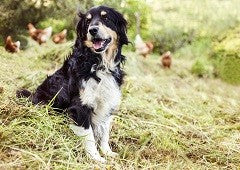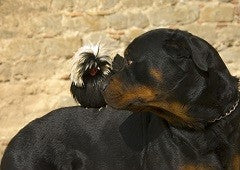Dogs and chickens - many approach this combination of backyard animals with hesitancy, but don’t let that deter you. You really can have both sets of animals share the same backyard without them being at risk - they can even become the best of friends! “Yes, yes - but this won’t be the case with my dog” we hear you say. “My dog is different, and will definitely eat the chickens!” Well, we’ve seen the proof that any dog of all breeds and sizes can get along with a backyard flock of chickens - take it from some of our thousands of followers, readers, subscribers and customers who have kindly sent us in their stories and photos, and shared with us their tips and advice when it comes to keeping dogs and chickens together in the same household. We’ve done it ourselves with our own feathered and furry family.
Cass Vailalo - Proud owner of a Dalmatian, a Great Dane and 6 chickens!
Cass was very keen to integrate a mixed flock of chickens into the life of their backyard, which already consisted of a Dalmatian and a Great Dane. The dogs had never interacted with chickens before, so Cass thought a lengthy introductory period would be the best.
1. Introducing the animals
Cass actually raised her chickens from day old chicks, therefore she took lots of caution where the dogs were involved. “Our dogs weren’t raised with chickens so for a number of years the dogs would go on a run/tied up whenever we let the hens out to free range.”
Cass started the interactions between the two animals whilst the chicks were still the size of a handful! “We raised a batch of day olds and would let the dogs sniff them etc. while we nursed chicks.
“We raised a batch of day olds and would let the dogs sniff them etc. while we nursed the chicks”
2. Changing tactics as the chickens grow
Soon, the babies turned into hens - and so Cass began to foster the correct behaviours that would allow both animals to free range together. “The dogs gradually got better, but I did find if the hens flapped about and ran around silly (as hens often do!) this would excite the dogs to chase.”
Cass learned to manage this behaviour by “only ever having one dog loose off with the hens at a time”, so it was easier to train them separately (rather than have them encourage bad habits in each other!) Over time, the dogs adjusted and got used to their feathered friends, however Cass “still sticks by her one dog off rule - natural instinct is too much to overcome with pack hunting.” In fact, her dalmatian even sees the benefits of having chickens - “my dalmatian actually spends a lot of time waiting for any leftover food scraps that the chooks don’t eat, so he thinks they’re a good thing!”
Top tips from Cass’s story:
- If you’ve got more than one dog and are worried they will encourage each other to chase, just let one off at a time when the chickens are free ranging.
- If you’re raising baby chicks, keep in mind they’re particularly vulnerable - but still introduce them to your dogs in the safety of your hands.
Jules McInnes - Proud owner of a Whippet, Jack Russell Terrier, a Cairn Terrier and 12 chickens!
Jules has quite the cluster of animals in her backyard - three dogs and twelve chickens no less! However, she has trained all her animals to co-eggsist harmoniously in the same backyard.
1. Introducing the chickens to the Jack Russell Terrier
The Jack Russell Terrier was a family pet before the introduction of the chickens, so was the first to meet all the new feathered friends. Jules didn’t really have any issues with aggression in her dog - quite the opposite in fact! “We only have large chicken breeds - we would feed the chooks and he would go and try to eat the scraps. One of the big girls used to peck at him when he did that, so he became nervous of them. We also have clucky hens with babies who chase him away! He learned to keep his distance.”
2. Next up, the Cairn TerrierFortunately, Jules didn’t have much of an issue with her sweet natured Cairn Terrier either (the benefits of having calm, gentle dogs!) “The Cairn Terrier loves all animals and would lick to death if she could get close enough! When they walk away from her, she gives up.”
3. Lastly, the wonderful Whippet
The Whippet, unlike her other dogs, did require a bit more effort in training due to its naturally excitable nature. “We used to only do supervised time to start with. He was allowed to approach them calmly, but if he was too rambunctious he would get a squirt with the water pistol.”
“We used to only do supervised time to start with. He was allowed to approach them calmly, but if he was too rambunctious he would get a squirt with the water pistol.”
Jules also invoked some behaviours in her chickens so her dogs could get a feel for every scenario, and make them comfortable with the flock whether they were quietly free ranging, or running around in a flap! “We also make the chooks run and flap, as that’s when most dogs get excited. If he took after them, he got a squirt with the water pistol again. He soon learnt, and it took about 3-4 weeks before we trusted him. Then we would let them all unsupervised but with us still at home.”
Now the flock and their canine friends all happily share the backyard - and Jules has an egg-stra advantage on her hand to keep the peace - “Having a bossy chook helps! She puts everyone in their place if she thinks they need it.”
Top tips for Jules's story
- One size may not fit all when it comes to your dogs - some may be comfortable with your chickens immediately, others may need a bit of training. Make the effort with all your furry pals. Every dog is different.
- Using negative reinforcement for bad behaviour (such as a squirt with a water pistol) is a good way to teach your dogs what’s acceptable around your chickens.
- Make sure your dogs are familiar with most of your chickens behaviours before leaving them unsupervised - i.e. running and flapping.
Dogs and chickens can certainly co-exist peacefully and become best friends, even protectors - if you need more help or are curious about the topic, check out our other articles on dogs and chickens on our Learning Centre. If you’re currently training your animals to co-exist with your chickens, please email through photos and share your stories - we love telling our followers about friendships between all animals - furry, feathered and fuzzy!
All chicken keepers want harmony amongst their flock and within a multi-pet household. To do an eggcellent job when caring for our feathered friends, we need effective expert advice. Many chicken keepers struggle to handle chicken health or behaviour issues, especially in the first few years of having a flock.
This is why I recommend Chickenpedia to all my readers. They have comprehensive online courses on everything you didn’t know you need to know and then some more! From healthcare to raising baby chicks to feeding and behavior, you’ll find beginner-friendly courses that’ll give you the knowledge and confidence to successfully look after your chickens.
As a member, you will get access to ALL their fantastic courses. No need to wing it, become the ultimate chicken eggspert! Check out Chickenpedia today!

















